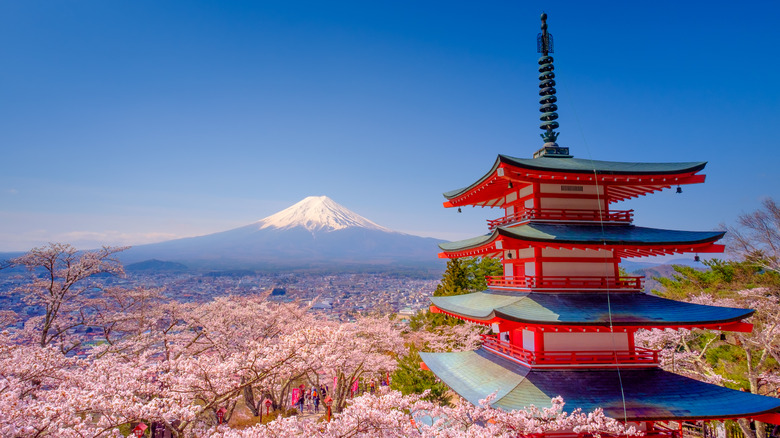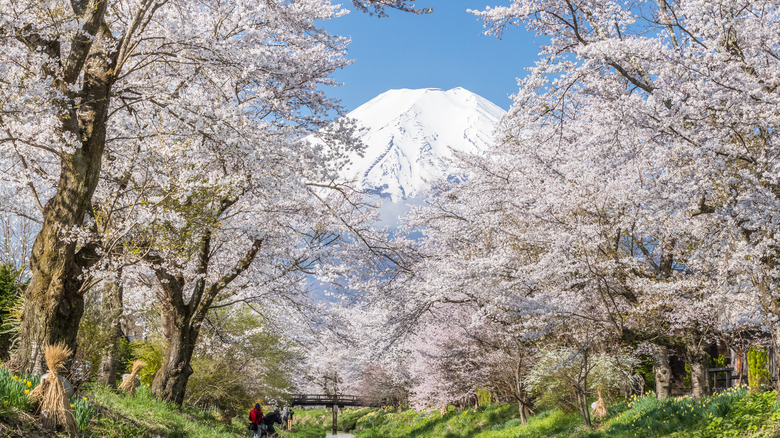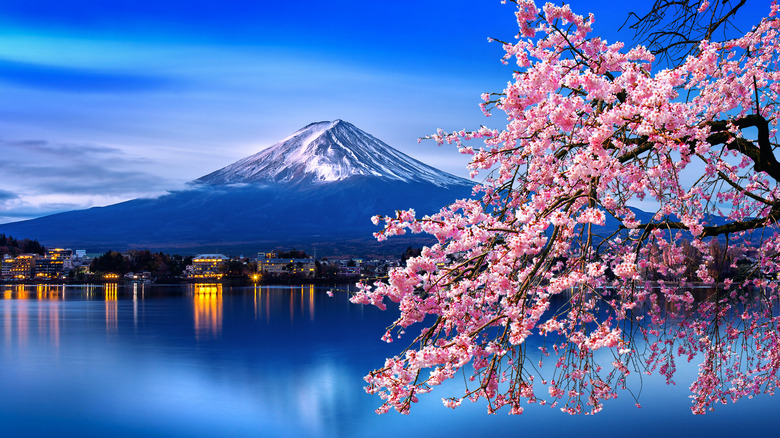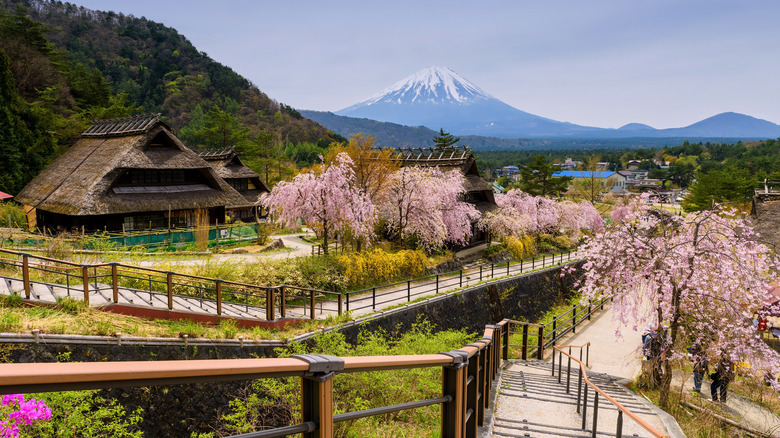April Is The Best Time To Visit Fujigoko For Breathtaking Cherry Blossom Photos
Sakura hanami, or the practice of cherry blossom viewing, is a traditional Japanese custom. Family and friends gather together under the sakura or cherry blossom trees to enjoy the beautiful blooms while they last, along with food and drink, per Live Japan. The sakura flower is Japan's national flower and is a symbol of spring, renewal, and life's brevity, according to Sakura in High Park.
There's no shortage of sakura-viewing sites in Japan, but the Fuji Five Lakes or Fujigoko region in the Yamanashi Prefecture is one of the best places to do so. The lake resort area is well-known for the various outdoor activities you can do there, such as fishing, hiking, and camping, as well as for having great views of Mount Fuji, according to Japan Guide. When it comes to Fujigoko's cherry blossoms, the flowers start to bloom in April, but mid-month is the best time to visit when the blooms reach their peak, according to Kyuhoshi.
Best views of cherry blossoms and Mount Fuji
There are several locations you can visit to see the region's sakuras in full bloom. One of the top spots you should travel to for cherry blossom viewing is Chureito Pagoda. Located in the hills of Fujiyoshida City, just a several minutes walk from Shimoyoshida Station, the pagoda is best visited during the early morning, according to Japan Guide. Kyuhoshi suggests heading to the observation deck to get the perfect photo with Mount Fuji and the cherry blossoms as your background.
Oshino Hakkai, popular for its eight spring-water ponds, is another most-visited site for viewing sakuras in bloom. It features hundreds of feet of cherry trees lining the site's northwestern side. Japan Guide suggests going to the bridge for a photo with views of the water or the Shibokusa Shrine for a pic of the cherry blossoms and Mount Fuji as your backdrop. Or, visit the traditional Japanese village to take a snap of the thatched-roof houses with Mount Fuji in the background, per Japan-Wireless.
Fuji Kawaguchiko Cherry Blossom Festival views
Around 300 cherry trees line the north shore of Lake Kawaguchiko, and when they bloom, the sakura blossoms extend for more than 3,000 feet, according to Japan-Wireless. Plus, pink shibazakura (known as moss phlox, creeping phlox, and phlox subulata in English per DMC Japan by KNT) are also flowering along the lakeshore. Walk along the river under the shade of cherry blossoms and take in the sight of Mount Fuji in real life. Afterward, Japan Guide recommends going to the lakeside promenade located on the eastern side of the Kawaguchiko Music Forest to snap a shot of the blooms and Mount Fuji.
The blossoming of the sakura flowers also signifies the start of the Fuji-Kawaguchiko Cherry Blossom Festival. The annual event attracts many tourists who enjoy the views as well as local food, drinks, and crafts. At night, the cherry blossoms are lit up, giving visitors another splendid look at the blooms, according to Japan-Wireless.
Where to view weeping cherry trees
There are many varieties of cherry trees in Japan, but one of the most popular and stand out is the weeping cherry tree or shidarezakura. So called because of the drooping branches that characterize it, the weeping cherry tree is also called itozakura or thread cherry blossoms as the branches look like thin threads, according to Live Japan. Weeping cherry trees bear pink, white, or red flowers and typically bloom from around late March to April.
In the Fujigoko region, weeping cherry trees can be found in the eastern shores of Kawaguchiko and Iyashi no Sato, an open-air museum and traditional craft village on the western shores of Lake Saiko. In the former, you'll find them in the town's ryokans, or traditional Japanese inns, and around the lower station of Mount Fuji Panoramic Ropeway, per Live Japan, in addition to the several rows of weeping cherry trees along the eastern side of Lake Kawaguchiko, according to Kyuhoshi. Meanwhile, in Iyashi no Sato, weeping cherry trees line the main street of the village, according to Japan Guide.



